piano
Berbiguier - Grande Fantaisie - Flute & Piano
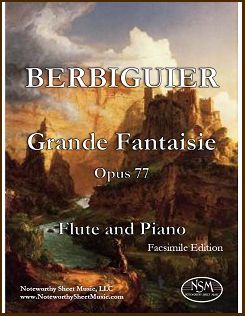 Grande Fantaisie, Op. 77, by T. Berbiguier
Grande Fantaisie, Op. 77, by T. Berbiguier
Gassett Collection - Facsimile Edition by C.A.Vater/Noteworthy Sheet Music, with a Foreword by Peter H. Bloom
Flute and Piano Parts, PDF $16.99
Benoit Tranquille Berbiguier (1782-1838) was among the preeminent European flutists of the early nineteenth century. Berbiguier was a prolific composer, and his nearly 150 published works include sets of duos and trios for flutes, as well as music that features flute with piano, orchestra, and chamber ensembles. His Grande Fantaisie avec Variations pour Flûte avec Accompagnement de Piano Forte (Opus 77) was composed on two motifs from Der Freischütz, Carl Maria von Weber's monumental opera which premiered in Berlin in 1821 and became an immediate international sensation. Sheet music for flute and piano.
For additional information about the Gassett Collection, please see see our article An Introduction to the Gassett Collection.
Piano part, 9 pages; Flute part, 8 pages; Total, 24 pages.
Berbiguier - Les Regrets - Flute & Piano
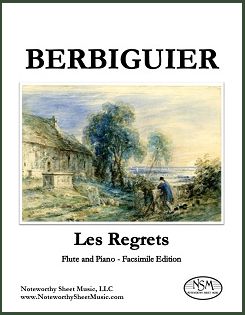 Les Regrets, Op.104, by T. Berbiguier
Les Regrets, Op.104, by T. Berbiguier
Gassett Collection - Facsimile Edition by C.A.Vater/NSM, with a Foreword by Peter H. Bloom
Flute Part and Piano Score, PDF $18.00
Berbiguier dedicated Les Regrets (Mélodie Concertante, Opus 104) to his close friend, the composer-'cellist Pierre-Louis Hus-Desforges. Les Regrets appears to be a missive of consolation from one musical colleague to another, both disillusioned and scarred veterans of decades of nationalist French intrigue. Though the initial theme is a plaintive rendering of a dour dead-march, its development is mournfully elegant. The subsequent developments serve to uplift performer and listener with a musical meditation that, though turbulent, avoids bathos. Dashes of a bit of scherzo here and there move the music, ultimately, to an heroic major-key finale.
For additional information about the Gassett Collection, please see see our article An Introduction to the Gassett Collection.
Piano score, 18 pages; Flute part, 6 pages; Total, 32 pages.
PreviewBerbiguier - Nouvelle Fantaisie - Flute & Piano
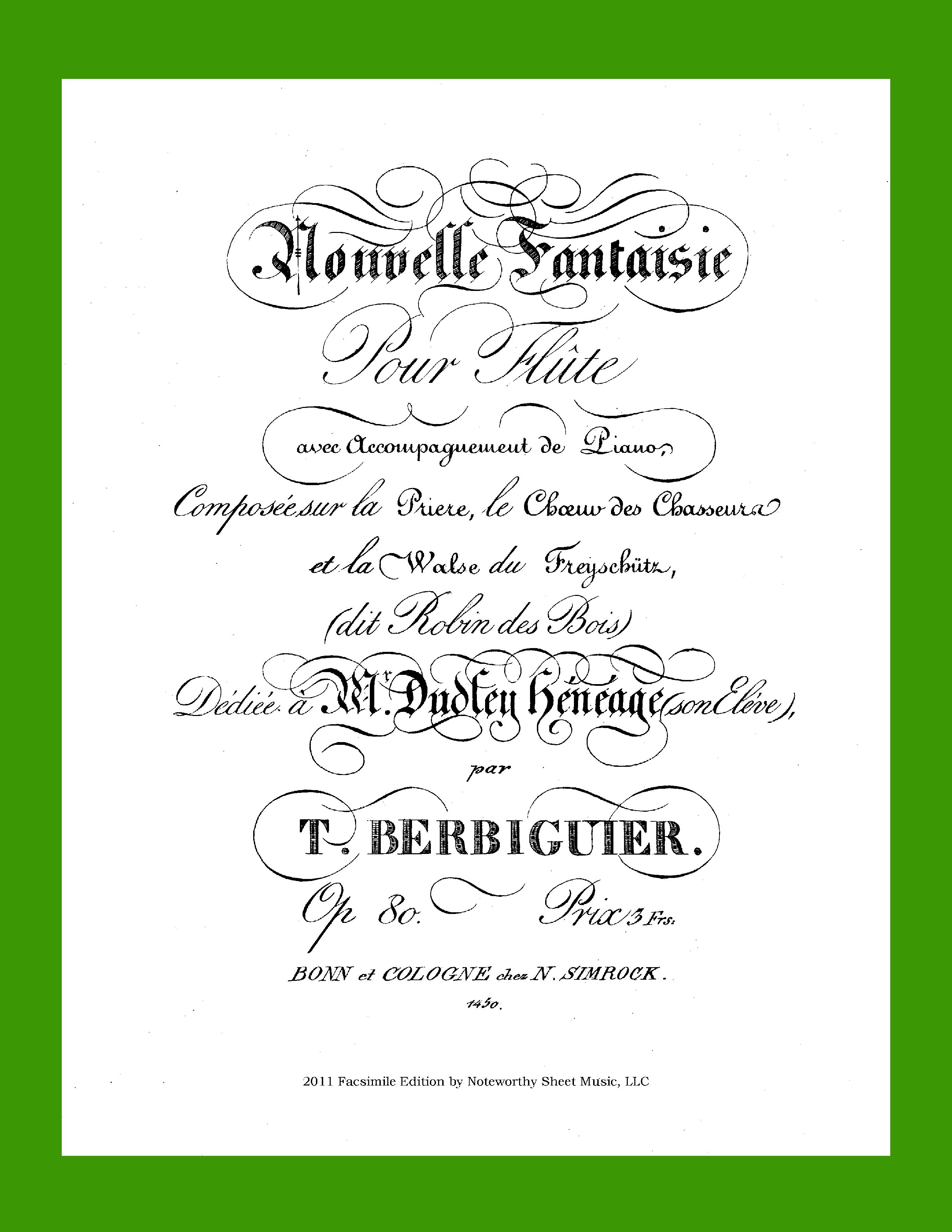 Nouvelle Fantaisie pour Flûte, Op. 80, by T. Berbiguier
Nouvelle Fantaisie pour Flûte, Op. 80, by T. Berbiguier
Gassett Collection - Facsimile Edition by C.A.Vater/Noteworthy Sheet Music, with a Foreword by Peter H. Bloom
Flute and Piano Parts, PDF $13.50
Berbiguier's Nouvelle Fantaisie (Opus 80), like his Grande Fantaisie (Opus 77), was composed on melodies from Carl Maria von Weber's genre-defining opera Der Freischütz. Both pieces were published around 1825. Enthusiasm for Der Freischütz continued to build in subsequent decades, as evinced by the nearly numberless fantaisies, paraphrases, souvenirs, and variations that have been published. Melodies from Freischutz pervade the classic repertoire of instruments from aeolian pianola to zither, including examples for concertina, mandolin, saxophone, and ocarina quartet. Piano and flute sheet music.
For additional information about the Gassett Collection, please see see our article An Introduction to the Gassett Collection.
Piano part, 11 pages; Flute part, 7 pages
PreviewBloch - Petite Fantaisie Hongroise - Pf & Afl
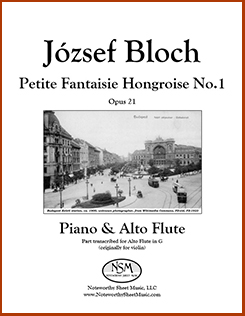 Petite Fantaisie Hongroise No.1, Op.21, by J. Bloch
Petite Fantaisie Hongroise No.1, Op.21, by J. Bloch
Transcribed for Alto Flute and Piano by C.A.Vater
Piano Score and Alto Flute Part, PDF $5.99
József Bloch (1862-1922) was a Hungarian violin virtuoso, composer, and professor at the National Academy of Music and the National Conservatory (www.jewishencyclopedia.com). His Petite Fantaisie Hongroise No.1, Opus 21, was written for piano and violin and published by Bárd, ca. 1901. We thought this piece would work beautifully on alto flute, so we created a transcription of the violin part. In the range written for the Petite Fantaisie Hongroise, the alto flute may evoke the dark, mournful tone of the modern tárogató, which is often referred to as the Hungarian national instrument. We provide both our transcribed alto flute part and a re-notated edition of the piano score.
Alto Flute part, 3 pages; Piano Score, 6 pages; Total, 12 pages.
Preview=================================
For those who would prefer to purchase a professionally-printed hard copy of this piece, rather than the PDF download offered above, our print edition of the Bloch Petite Fantaisie Hongroise No.1, Op. 21 transcribed for Piano & Alto Flute is available directly from NSM for $13.49 plus a $5.95 shipping and handling fee to addresses in the USA. Use the Contact Us form to let us know which hard copy publication(s) you would like to purchase, along with your email contact information and USPS mailing address. We will then send you a PayPal invoice for the sale and, once we receive notice from PayPal that you have paid for the item(s), we will ship your music to the address provided.
Brahms - Drei Duette - 2 Voices and/or Instruments and Piano
 Drei Duette, Op.20, by Johannes Brahms
Drei Duette, Op.20, by Johannes Brahms
Transcribed for Mixed Voice, Instruments, and Piano by John W. Pratt
Score for Soprano, Alto, and Piano; Transcribed upper voice Parts for Violin/Oboe, Alto Flute, and A-Clarinet; and Transcribed lower voice Parts for Violin/Oboe, Alto Flute, A-Clarinet, and Viola; PDF $12.99
Composed in 1858–1860, the Drei Duette, Op. 20, for soprano and alto are the earliest of Johannes Brahms' duets and quartets for solo voices and piano. The three songs are titled Weg der Liebe (1. Teil), Weg der Liebe (2.Teil), and Die Meere. Except for brief canonic passages in No. 1, the voices have the same words, sung simultaneously, mostly in parallel thirds and sixths. The accompaniments are straightforward, without Brahmsian ensemble challenges but not without harmonic interest. Many have found the songs Mendelssohnian. The words come from the collection Stimmen der Völker of Johann Gottfried Herder (1744–1803). The first two are translations by Herder of two parts of a Northern English folk poem Love will find out the Way. The third is Italian in origin.
The vocal parts lie well for many instruments, opening the possibility of mixed voice and instrument, as well as fully-instrumental, performances. If one voice is replaced by an instrument, no words will be lost and the result will be a song with wonderful instrumental obbligato and piano accompaniment. If two instruments are used, the result is a beautiful "song without words." We include in our edition transcriptions of both voices for oboe/violin, alto flute in G, and clarinet in A, and of the lower voice for viola as well. Our transcriptions provide slurs to suggest a vocal style to instrumental players and to facilitate coordination of the instrumental parts with those of the voices. We also provide a re-notated piano/vocal score, in which repeat signs are used in the second and third songs to save page turns, rather than writing out the multiple stanzas as in the original. For those needing only the piano/vocal score, the Breitkopf & Härtel edition is in the public domain and freely available on imslp.org.
Piano/Vocal Score, 10 pages; Instrumental Parts, 3 pages each; Total, 42 pages.
PreviewBrahms - Var. on a Theme of R. Schumann - Piano
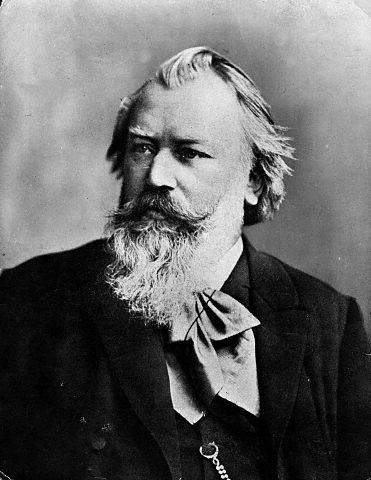 Variations on a Theme of Robert Schumann, Op.23, by J. Brahms
Variations on a Theme of Robert Schumann, Op.23, by J. Brahms
Transcribed for Piano Solo by John W. Pratt, PDF $19.75
Brahms wrote his beautiful Variationen über ein Thema von Robert Schumann for piano four hands, but essentially all the musical ideas are captured in this transcription for solo piano. The variations range from delicately decorative to spectral to warmly Brahmsian to bravura and even witty. The last, suffused with sadness, solemnity, resignation, and reaffirmation, combines a funeral march with the theme, which is known as Schumann's last idea because it came to him at night shortly before his attempted suicide and final commitment to an asylum.
Piano score, 21 pages; Total, 23 pages.
PreviewBrahms – Variationen über ein Thema von Robert Schumann – Pf, Fl, Ob, Cl, Bn
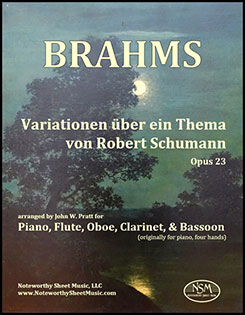 Variationen über ein Thema von Robert Schumann, Op.23, by Johannes Brahms
Variationen über ein Thema von Robert Schumann, Op.23, by Johannes Brahms
Arranged for Piano, Flute, Oboe, Clarinet, and Bassoon by John W. Pratt
Piano Score and Wind Parts, PDF $16.99
- adapted from John W. Pratt’s foreword to the edition: Brahms’s Variations on a Theme by Robert Schumann, Op.23, were written in tribute to his friend, for piano four hands. Yet how often have you heard this exquisite masterpiece, in any form? Arranging it as a quintet for piano and winds allows realization of its implicit orchestral effects and incorporation of contrasting and beautiful woodwind sonorities while preserving its many special piano sonorities and its personal, chamber music qualities and will, hopefully, encourage performance. The variations range from delicately decorative (Var. I) to spectral (IV) to warmly Brahmsian (many) to bravura (IX) and even perhaps witty (V and VII). The final variation (X) is an amazing valedictory, a funeral march which becomes combined with the theme and is suffused throughout with sadness, solemnity, resignation, and reaffirmation, by turns and even simultaneously. Especially apt contributions by the woodwinds in this arrangement include, to mention just two, the appreciative chuckles accompanying the rollicking theme of Var. V and the chorale effect at the end of Var. X. At the same time, the arrangement allows the piano to fulfill its usual roles in chamber ensembles and to contribute some special colorings of its own, including the multi-octave filigree of Var. I, the layout of the accompaniments in the first part of Var. III and last part of Var. V, the bass rumbles of Var. IV and Var. X, and the two-hand octaves in Var. VI and Var. IX.
Listen to a computer-generated audio clip of the Theme; of course, real live instruments will sound even better:
The Preview below is a page of the score from Var. VI. Note that the score is presented in concert pitch.
Score, 28 pages; Flute, Oboe, B-flat Clarinet, and Bassoon parts, 4 pages each; Total, 48 pages.
PreviewBriccialdi - Fantaisie pour la Flûte - Fl & Pf
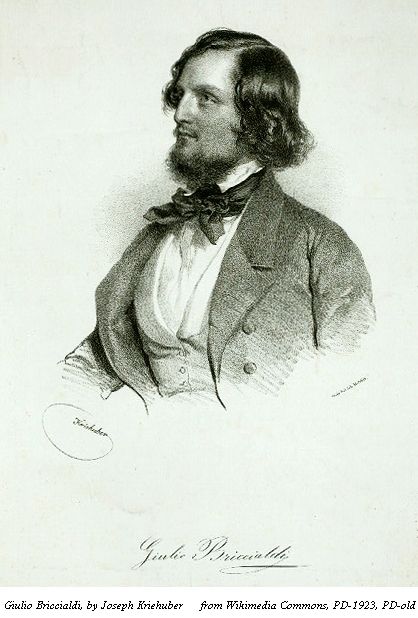 Fantaisie pour la Flûte, Op.110, by Briccialdi
Fantaisie pour la Flûte, Op.110, by Briccialdi
Gassett Collection - Facsimile Edition by C.A.Vater/Noteworthy Sheet Music
Flute Part and Piano Score, PDF $13.50
The virtuoso Italian flutist Giulio Briccialdi (1818-1881) was a captivating performer and a brilliant and prolific composer of works for the flute. His compositions became highly popular among flutists and include several concerti and numerous duets, caprices, fantasies, and etudes. He served as professor of flute at the Academy of St. Cecilia in Rome and later at the Florence Conservatoire. A proponent of the Boehm flute, Briccialdi is best known today for his invention of the Briccialdi B-flat thumb key and for his variation on the Carnival of Venice, "Il Carnevale di Venezia" (Op.78). We offer here our facsimile edition of his charming, challenging, and otherwise unavailable Fantaisie pour la Flûte sur des motifs de l'opera La Sonnambula de Bellini (Op.110).
For additional information about the Gassett Collection, please see see our article An Introduction to the Gassett Collection.
Piano score, 13 pages; Flute part, 5 pages; Total 23 pages.
PreviewBridge – Two Pieces: Pensiero and Allegro appassionato – trans. for Clarinet and Piano
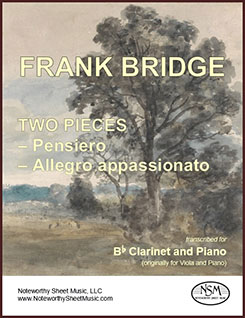 Two Pieces: Pensiero and Allegro appassionato, by Frank Bridge
Two Pieces: Pensiero and Allegro appassionato, by Frank Bridge
Transcribed for B-flat Clarinet and Piano by C.A.Vater
Score and Part; PDF $10.99
Certain chamber works written for viola can also work very beautifully when transcribed for clarinet, and indeed may actually be coveted by clarinetists. Brahms’ Two Songs for Voice, Viola and Piano, Op. 91 is one such piece, and our transcription has become one of NSM’s most popular publications. Clarinetists may discover that our adaptation of the viola part of Frank Bridge’s Two Pieces: Pensiero and Allegro appassionato, written for viola and piano, is also well-conceived and enjoyable to play. As suggested by their titles, these two pieces were written in very different styles, but they complement each other well, showing off Bridge’s composing versatility and providing performers an opportunity to display a range of emotions and capabilities. In our edition, we have raised the Pensiero key from F minor to G minor, taken a few passages in both pieces 8va to bring them into clarinet range, and created clarinet-friendly adaptations for the viola’s occasional double stops, but otherwise the pieces remain as Bridge composed them.
Score, 10 pages; Clarinet part, 3 pages; Total, 16 pages.
PreviewCoste - Cavatine - Afl + Pf
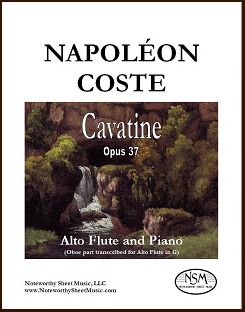 Cavatine, Op.37, by Napoléon Coste
Cavatine, Op.37, by Napoléon Coste
Transcribed for Alto Flute and Piano by C.A.Vater
Piano Score and Alto Flute Part, PDF $8.25
Napoléon Coste (1805-1883) was born in a small village in the Départment of the Doubs, France. He began to play guitar at the age of 6, studying with his mother who was an accomplished guitar performer. Napoléon himself began teaching and performing on guitar as a teenager. At age 24 he moved to Paris, where he studied under Fernando Sor, the renowned Spanish classical guitarist and composer. Coste quickly established himself as a virtuoso and is widely acknowledged as the dominant French guitarist of his era.
Coste became famous not only as a guitar soloist, but also as a major composer of some 60 works, most of which were written for guitar. His Op.37 "Cavatine" is a short, single-movement piece composed for piano and oboe (or violin or flute). The work is lovely, melodic but lively in places; it falls nicely within the range of the alto flute and sounds appealing and completely natural on that instrument. The Noteworthy Sheet Music edition includes a score for piano and alto flute, in addition to the transcribed alto flute part.
Alto Flute part, 3 pages; Piano Score, 8 pages; Total, 16 pages.
Preview